Optimal Taxation In Theories And Practice
VerifiedAdded on 2022/09/18
|14
|2888
|20
AI Summary
Contribute Materials
Your contribution can guide someone’s learning journey. Share your
documents today.
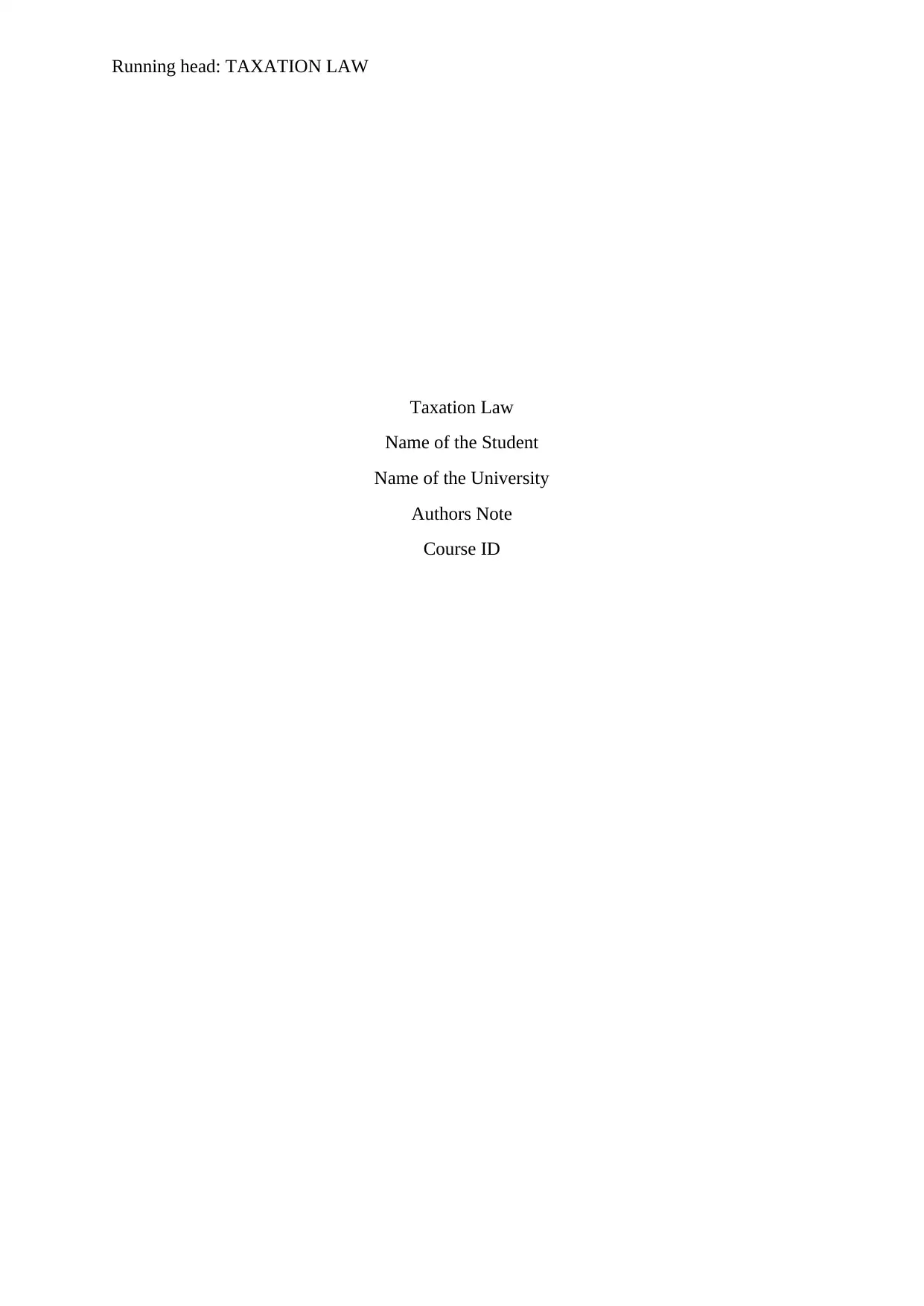
Running head: TAXATION LAW
Taxation Law
Name of the Student
Name of the University
Authors Note
Course ID
Taxation Law
Name of the Student
Name of the University
Authors Note
Course ID
Secure Best Marks with AI Grader
Need help grading? Try our AI Grader for instant feedback on your assignments.
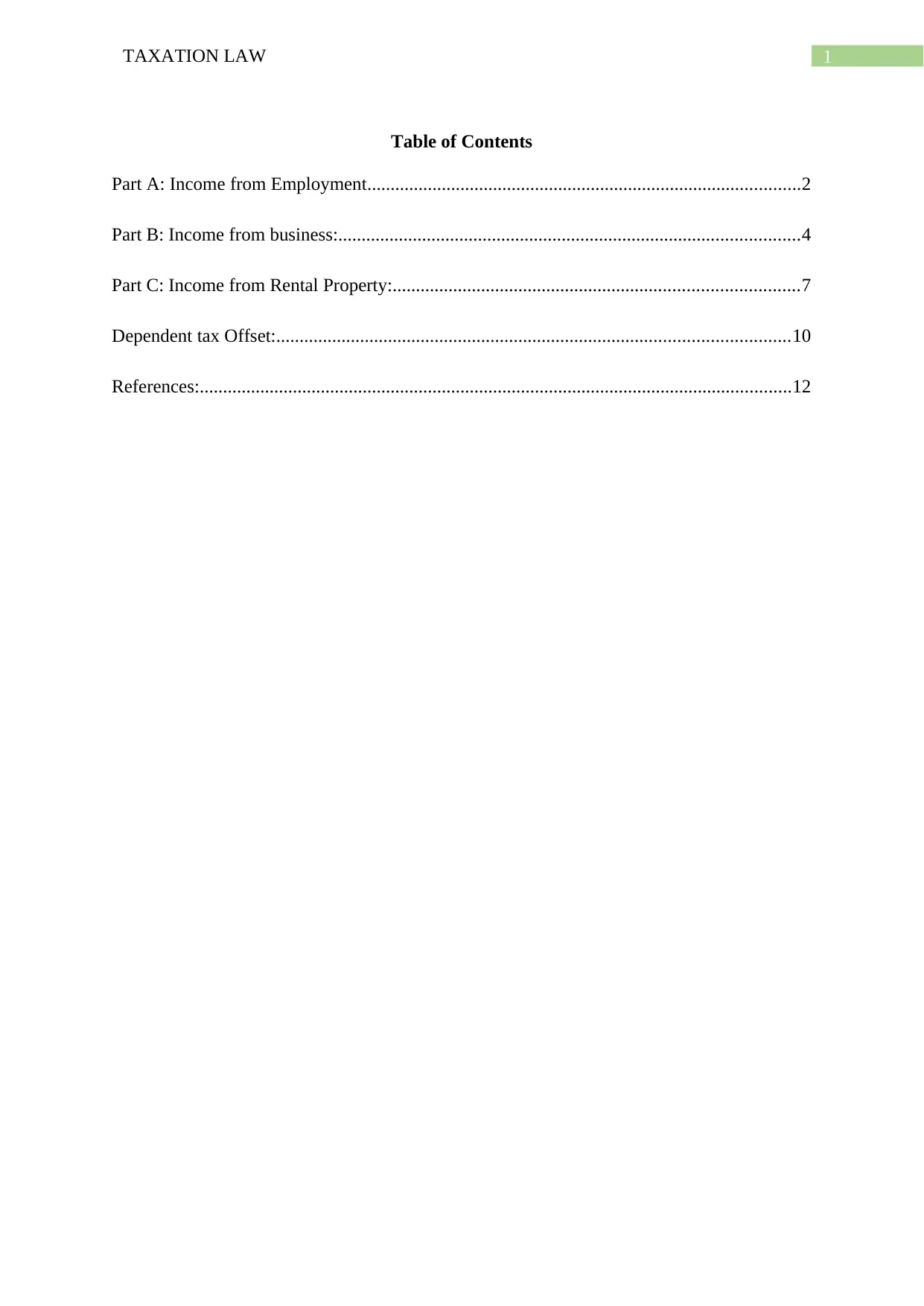
1TAXATION LAW
Table of Contents
Part A: Income from Employment.............................................................................................2
Part B: Income from business:...................................................................................................4
Part C: Income from Rental Property:.......................................................................................7
Dependent tax Offset:..............................................................................................................10
References:...............................................................................................................................12
Table of Contents
Part A: Income from Employment.............................................................................................2
Part B: Income from business:...................................................................................................4
Part C: Income from Rental Property:.......................................................................................7
Dependent tax Offset:..............................................................................................................10
References:...............................................................................................................................12
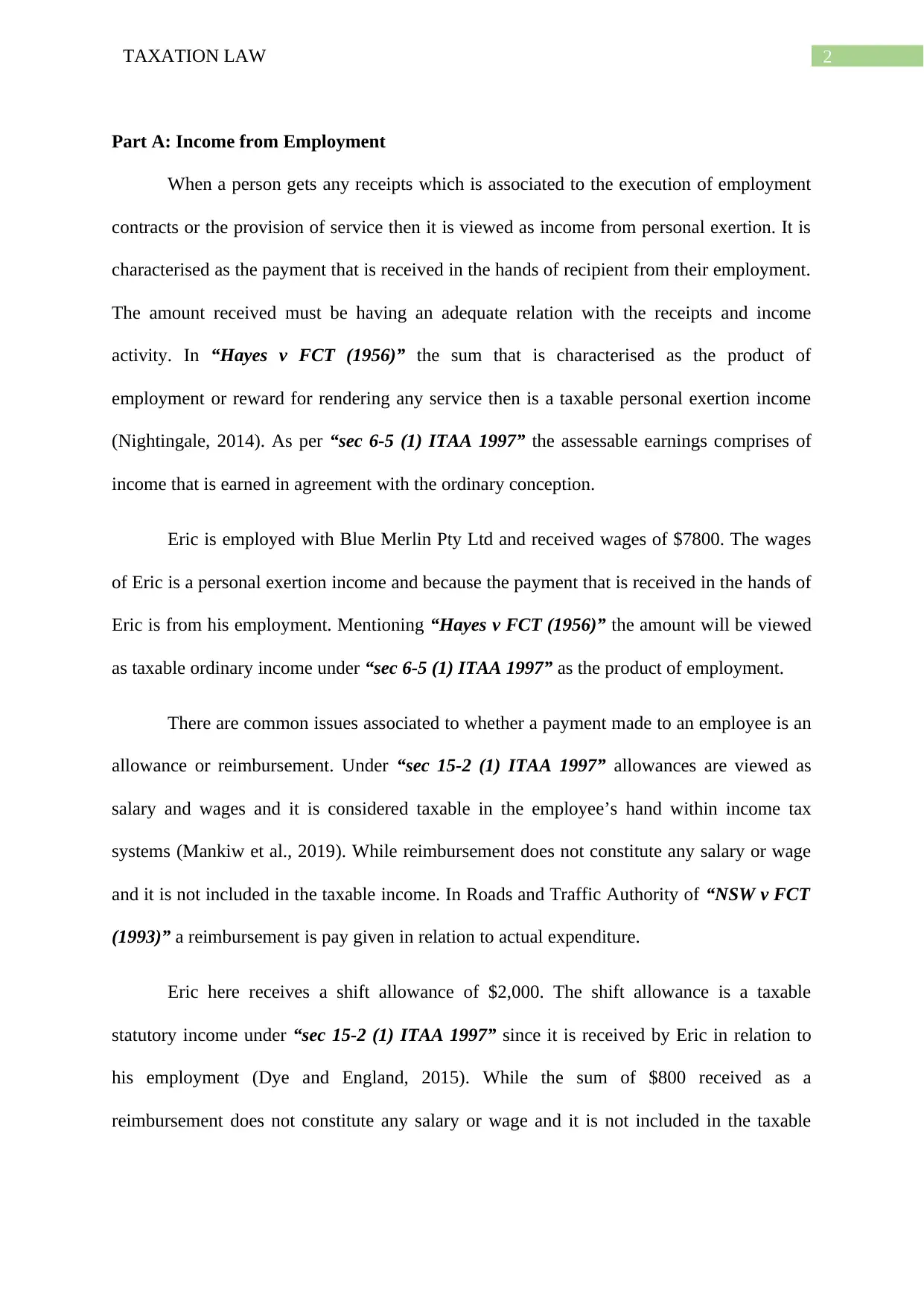
2TAXATION LAW
Part A: Income from Employment
When a person gets any receipts which is associated to the execution of employment
contracts or the provision of service then it is viewed as income from personal exertion. It is
characterised as the payment that is received in the hands of recipient from their employment.
The amount received must be having an adequate relation with the receipts and income
activity. In “Hayes v FCT (1956)” the sum that is characterised as the product of
employment or reward for rendering any service then is a taxable personal exertion income
(Nightingale, 2014). As per “sec 6-5 (1) ITAA 1997” the assessable earnings comprises of
income that is earned in agreement with the ordinary conception.
Eric is employed with Blue Merlin Pty Ltd and received wages of $7800. The wages
of Eric is a personal exertion income and because the payment that is received in the hands of
Eric is from his employment. Mentioning “Hayes v FCT (1956)” the amount will be viewed
as taxable ordinary income under “sec 6-5 (1) ITAA 1997” as the product of employment.
There are common issues associated to whether a payment made to an employee is an
allowance or reimbursement. Under “sec 15-2 (1) ITAA 1997” allowances are viewed as
salary and wages and it is considered taxable in the employee’s hand within income tax
systems (Mankiw et al., 2019). While reimbursement does not constitute any salary or wage
and it is not included in the taxable income. In Roads and Traffic Authority of “NSW v FCT
(1993)” a reimbursement is pay given in relation to actual expenditure.
Eric here receives a shift allowance of $2,000. The shift allowance is a taxable
statutory income under “sec 15-2 (1) ITAA 1997” since it is received by Eric in relation to
his employment (Dye and England, 2015). While the sum of $800 received as a
reimbursement does not constitute any salary or wage and it is not included in the taxable
Part A: Income from Employment
When a person gets any receipts which is associated to the execution of employment
contracts or the provision of service then it is viewed as income from personal exertion. It is
characterised as the payment that is received in the hands of recipient from their employment.
The amount received must be having an adequate relation with the receipts and income
activity. In “Hayes v FCT (1956)” the sum that is characterised as the product of
employment or reward for rendering any service then is a taxable personal exertion income
(Nightingale, 2014). As per “sec 6-5 (1) ITAA 1997” the assessable earnings comprises of
income that is earned in agreement with the ordinary conception.
Eric is employed with Blue Merlin Pty Ltd and received wages of $7800. The wages
of Eric is a personal exertion income and because the payment that is received in the hands of
Eric is from his employment. Mentioning “Hayes v FCT (1956)” the amount will be viewed
as taxable ordinary income under “sec 6-5 (1) ITAA 1997” as the product of employment.
There are common issues associated to whether a payment made to an employee is an
allowance or reimbursement. Under “sec 15-2 (1) ITAA 1997” allowances are viewed as
salary and wages and it is considered taxable in the employee’s hand within income tax
systems (Mankiw et al., 2019). While reimbursement does not constitute any salary or wage
and it is not included in the taxable income. In Roads and Traffic Authority of “NSW v FCT
(1993)” a reimbursement is pay given in relation to actual expenditure.
Eric here receives a shift allowance of $2,000. The shift allowance is a taxable
statutory income under “sec 15-2 (1) ITAA 1997” since it is received by Eric in relation to
his employment (Dye and England, 2015). While the sum of $800 received as a
reimbursement does not constitute any salary or wage and it is not included in the taxable
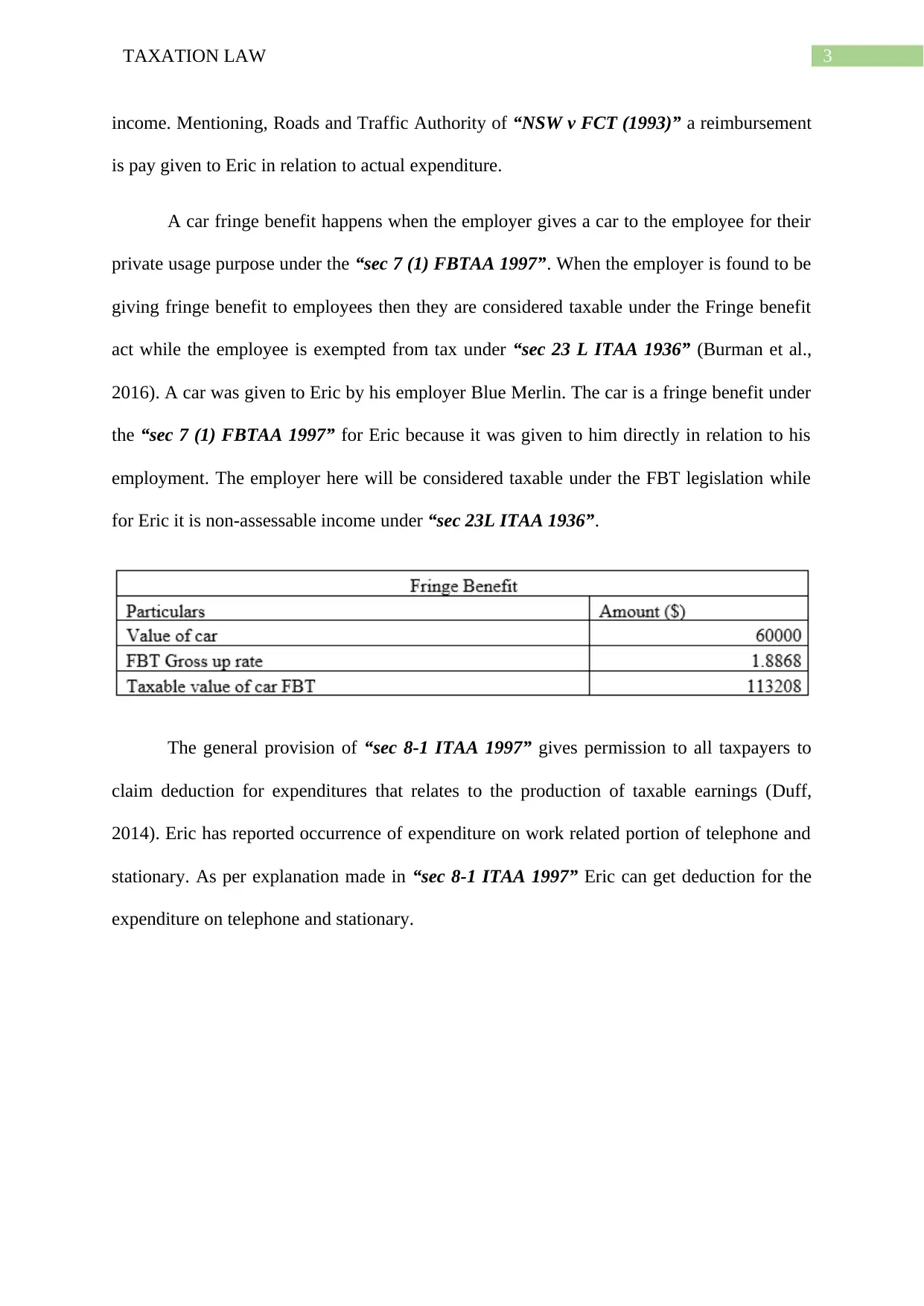
3TAXATION LAW
income. Mentioning, Roads and Traffic Authority of “NSW v FCT (1993)” a reimbursement
is pay given to Eric in relation to actual expenditure.
A car fringe benefit happens when the employer gives a car to the employee for their
private usage purpose under the “sec 7 (1) FBTAA 1997”. When the employer is found to be
giving fringe benefit to employees then they are considered taxable under the Fringe benefit
act while the employee is exempted from tax under “sec 23 L ITAA 1936” (Burman et al.,
2016). A car was given to Eric by his employer Blue Merlin. The car is a fringe benefit under
the “sec 7 (1) FBTAA 1997” for Eric because it was given to him directly in relation to his
employment. The employer here will be considered taxable under the FBT legislation while
for Eric it is non-assessable income under “sec 23L ITAA 1936”.
The general provision of “sec 8-1 ITAA 1997” gives permission to all taxpayers to
claim deduction for expenditures that relates to the production of taxable earnings (Duff,
2014). Eric has reported occurrence of expenditure on work related portion of telephone and
stationary. As per explanation made in “sec 8-1 ITAA 1997” Eric can get deduction for the
expenditure on telephone and stationary.
income. Mentioning, Roads and Traffic Authority of “NSW v FCT (1993)” a reimbursement
is pay given to Eric in relation to actual expenditure.
A car fringe benefit happens when the employer gives a car to the employee for their
private usage purpose under the “sec 7 (1) FBTAA 1997”. When the employer is found to be
giving fringe benefit to employees then they are considered taxable under the Fringe benefit
act while the employee is exempted from tax under “sec 23 L ITAA 1936” (Burman et al.,
2016). A car was given to Eric by his employer Blue Merlin. The car is a fringe benefit under
the “sec 7 (1) FBTAA 1997” for Eric because it was given to him directly in relation to his
employment. The employer here will be considered taxable under the FBT legislation while
for Eric it is non-assessable income under “sec 23L ITAA 1936”.
The general provision of “sec 8-1 ITAA 1997” gives permission to all taxpayers to
claim deduction for expenditures that relates to the production of taxable earnings (Duff,
2014). Eric has reported occurrence of expenditure on work related portion of telephone and
stationary. As per explanation made in “sec 8-1 ITAA 1997” Eric can get deduction for the
expenditure on telephone and stationary.
Secure Best Marks with AI Grader
Need help grading? Try our AI Grader for instant feedback on your assignments.
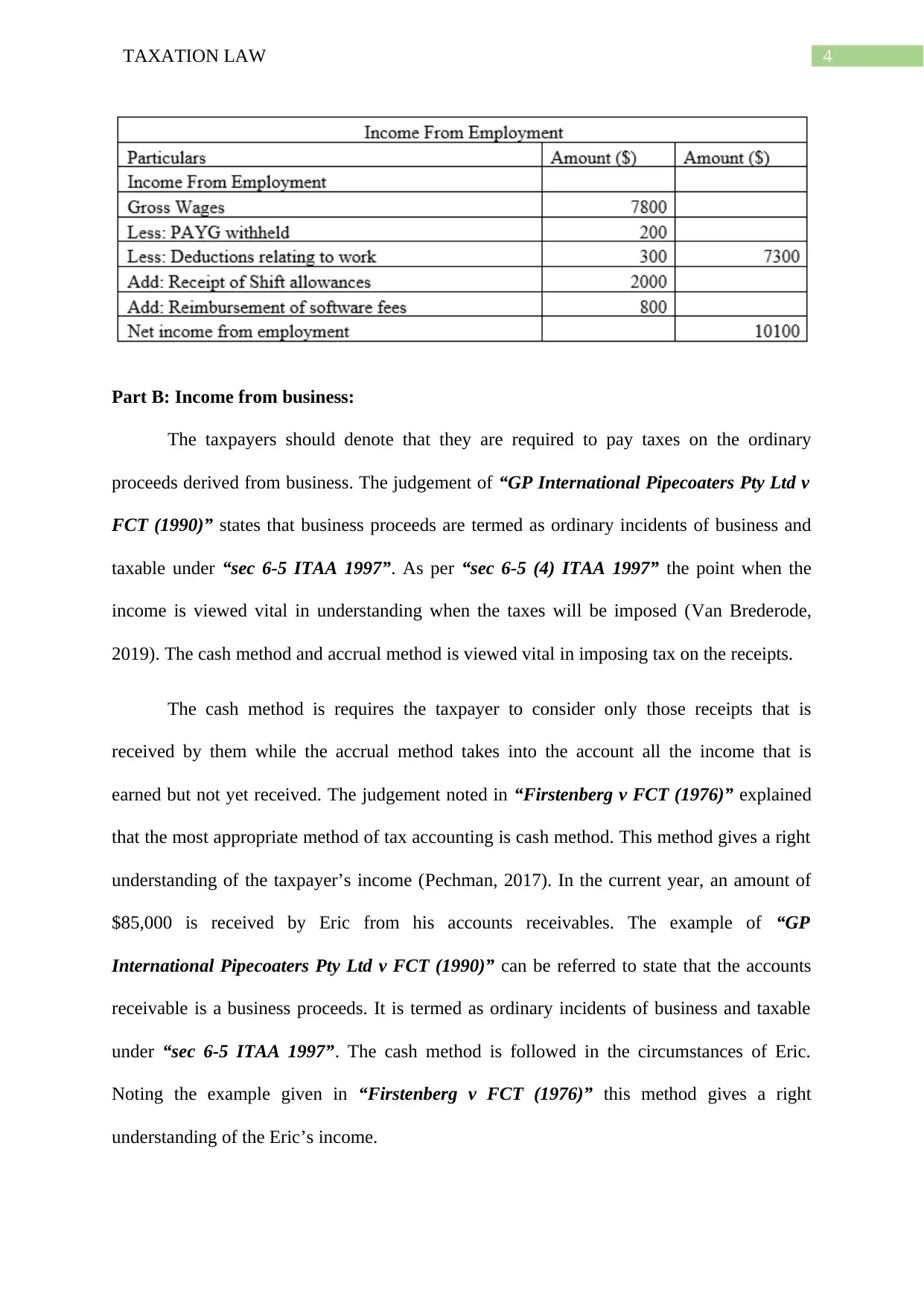
4TAXATION LAW
Part B: Income from business:
The taxpayers should denote that they are required to pay taxes on the ordinary
proceeds derived from business. The judgement of “GP International Pipecoaters Pty Ltd v
FCT (1990)” states that business proceeds are termed as ordinary incidents of business and
taxable under “sec 6-5 ITAA 1997”. As per “sec 6-5 (4) ITAA 1997” the point when the
income is viewed vital in understanding when the taxes will be imposed (Van Brederode,
2019). The cash method and accrual method is viewed vital in imposing tax on the receipts.
The cash method is requires the taxpayer to consider only those receipts that is
received by them while the accrual method takes into the account all the income that is
earned but not yet received. The judgement noted in “Firstenberg v FCT (1976)” explained
that the most appropriate method of tax accounting is cash method. This method gives a right
understanding of the taxpayer’s income (Pechman, 2017). In the current year, an amount of
$85,000 is received by Eric from his accounts receivables. The example of “GP
International Pipecoaters Pty Ltd v FCT (1990)” can be referred to state that the accounts
receivable is a business proceeds. It is termed as ordinary incidents of business and taxable
under “sec 6-5 ITAA 1997”. The cash method is followed in the circumstances of Eric.
Noting the example given in “Firstenberg v FCT (1976)” this method gives a right
understanding of the Eric’s income.
Part B: Income from business:
The taxpayers should denote that they are required to pay taxes on the ordinary
proceeds derived from business. The judgement of “GP International Pipecoaters Pty Ltd v
FCT (1990)” states that business proceeds are termed as ordinary incidents of business and
taxable under “sec 6-5 ITAA 1997”. As per “sec 6-5 (4) ITAA 1997” the point when the
income is viewed vital in understanding when the taxes will be imposed (Van Brederode,
2019). The cash method and accrual method is viewed vital in imposing tax on the receipts.
The cash method is requires the taxpayer to consider only those receipts that is
received by them while the accrual method takes into the account all the income that is
earned but not yet received. The judgement noted in “Firstenberg v FCT (1976)” explained
that the most appropriate method of tax accounting is cash method. This method gives a right
understanding of the taxpayer’s income (Pechman, 2017). In the current year, an amount of
$85,000 is received by Eric from his accounts receivables. The example of “GP
International Pipecoaters Pty Ltd v FCT (1990)” can be referred to state that the accounts
receivable is a business proceeds. It is termed as ordinary incidents of business and taxable
under “sec 6-5 ITAA 1997”. The cash method is followed in the circumstances of Eric.
Noting the example given in “Firstenberg v FCT (1976)” this method gives a right
understanding of the Eric’s income.
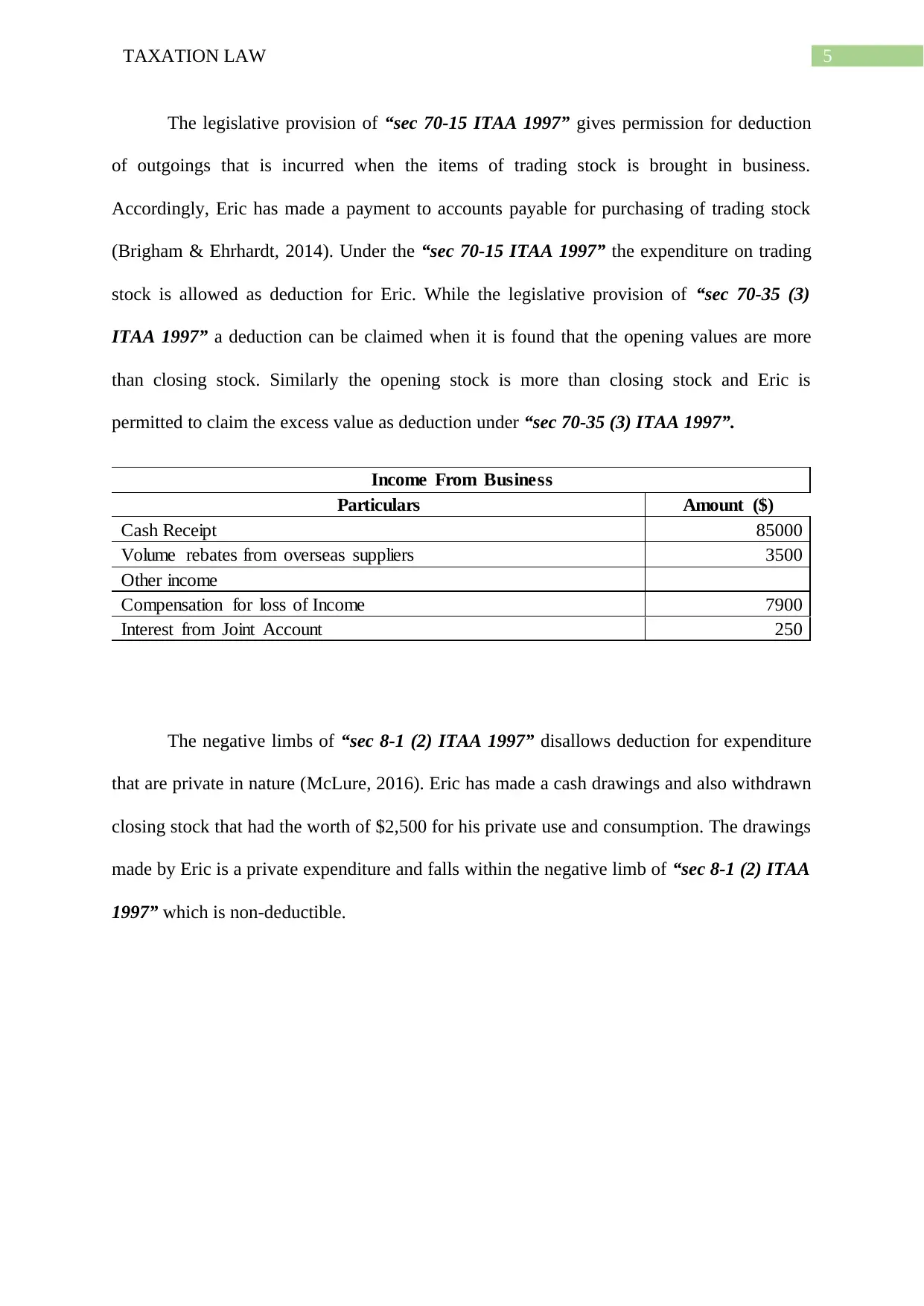
5TAXATION LAW
The legislative provision of “sec 70-15 ITAA 1997” gives permission for deduction
of outgoings that is incurred when the items of trading stock is brought in business.
Accordingly, Eric has made a payment to accounts payable for purchasing of trading stock
(Brigham & Ehrhardt, 2014). Under the “sec 70-15 ITAA 1997” the expenditure on trading
stock is allowed as deduction for Eric. While the legislative provision of “sec 70-35 (3)
ITAA 1997” a deduction can be claimed when it is found that the opening values are more
than closing stock. Similarly the opening stock is more than closing stock and Eric is
permitted to claim the excess value as deduction under “sec 70-35 (3) ITAA 1997”.
Income From Business
Particulars Amount ($)
Cash Receipt 85000
Volume rebates from overseas suppliers 3500
Other income
Compensation for loss of Income 7900
Interest from Joint Account 250
The negative limbs of “sec 8-1 (2) ITAA 1997” disallows deduction for expenditure
that are private in nature (McLure, 2016). Eric has made a cash drawings and also withdrawn
closing stock that had the worth of $2,500 for his private use and consumption. The drawings
made by Eric is a private expenditure and falls within the negative limb of “sec 8-1 (2) ITAA
1997” which is non-deductible.
The legislative provision of “sec 70-15 ITAA 1997” gives permission for deduction
of outgoings that is incurred when the items of trading stock is brought in business.
Accordingly, Eric has made a payment to accounts payable for purchasing of trading stock
(Brigham & Ehrhardt, 2014). Under the “sec 70-15 ITAA 1997” the expenditure on trading
stock is allowed as deduction for Eric. While the legislative provision of “sec 70-35 (3)
ITAA 1997” a deduction can be claimed when it is found that the opening values are more
than closing stock. Similarly the opening stock is more than closing stock and Eric is
permitted to claim the excess value as deduction under “sec 70-35 (3) ITAA 1997”.
Income From Business
Particulars Amount ($)
Cash Receipt 85000
Volume rebates from overseas suppliers 3500
Other income
Compensation for loss of Income 7900
Interest from Joint Account 250
The negative limbs of “sec 8-1 (2) ITAA 1997” disallows deduction for expenditure
that are private in nature (McLure, 2016). Eric has made a cash drawings and also withdrawn
closing stock that had the worth of $2,500 for his private use and consumption. The drawings
made by Eric is a private expenditure and falls within the negative limb of “sec 8-1 (2) ITAA
1997” which is non-deductible.
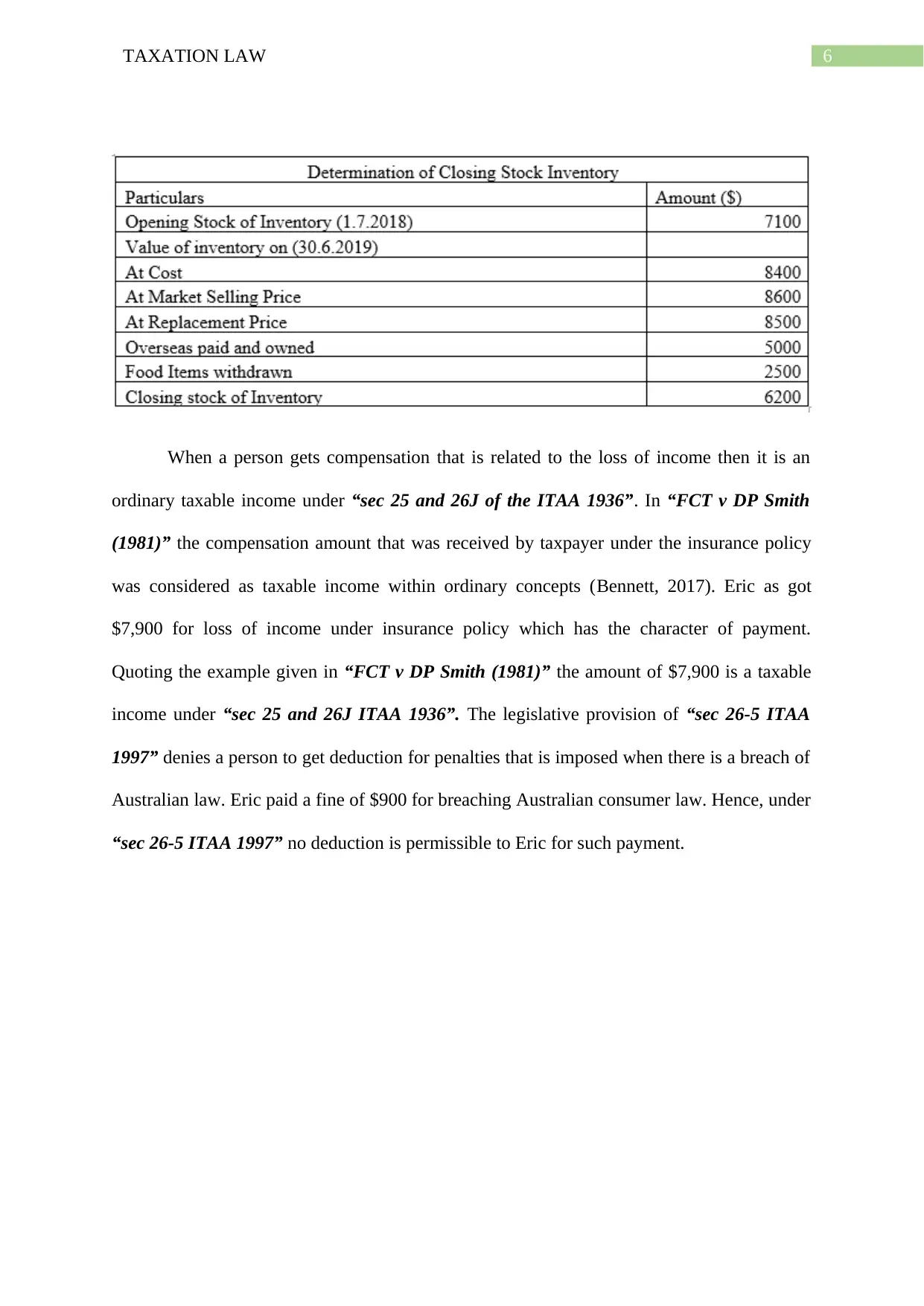
6TAXATION LAW
When a person gets compensation that is related to the loss of income then it is an
ordinary taxable income under “sec 25 and 26J of the ITAA 1936”. In “FCT v DP Smith
(1981)” the compensation amount that was received by taxpayer under the insurance policy
was considered as taxable income within ordinary concepts (Bennett, 2017). Eric as got
$7,900 for loss of income under insurance policy which has the character of payment.
Quoting the example given in “FCT v DP Smith (1981)” the amount of $7,900 is a taxable
income under “sec 25 and 26J ITAA 1936”. The legislative provision of “sec 26-5 ITAA
1997” denies a person to get deduction for penalties that is imposed when there is a breach of
Australian law. Eric paid a fine of $900 for breaching Australian consumer law. Hence, under
“sec 26-5 ITAA 1997” no deduction is permissible to Eric for such payment.
When a person gets compensation that is related to the loss of income then it is an
ordinary taxable income under “sec 25 and 26J of the ITAA 1936”. In “FCT v DP Smith
(1981)” the compensation amount that was received by taxpayer under the insurance policy
was considered as taxable income within ordinary concepts (Bennett, 2017). Eric as got
$7,900 for loss of income under insurance policy which has the character of payment.
Quoting the example given in “FCT v DP Smith (1981)” the amount of $7,900 is a taxable
income under “sec 25 and 26J ITAA 1936”. The legislative provision of “sec 26-5 ITAA
1997” denies a person to get deduction for penalties that is imposed when there is a breach of
Australian law. Eric paid a fine of $900 for breaching Australian consumer law. Hence, under
“sec 26-5 ITAA 1997” no deduction is permissible to Eric for such payment.
Paraphrase This Document
Need a fresh take? Get an instant paraphrase of this document with our AI Paraphraser
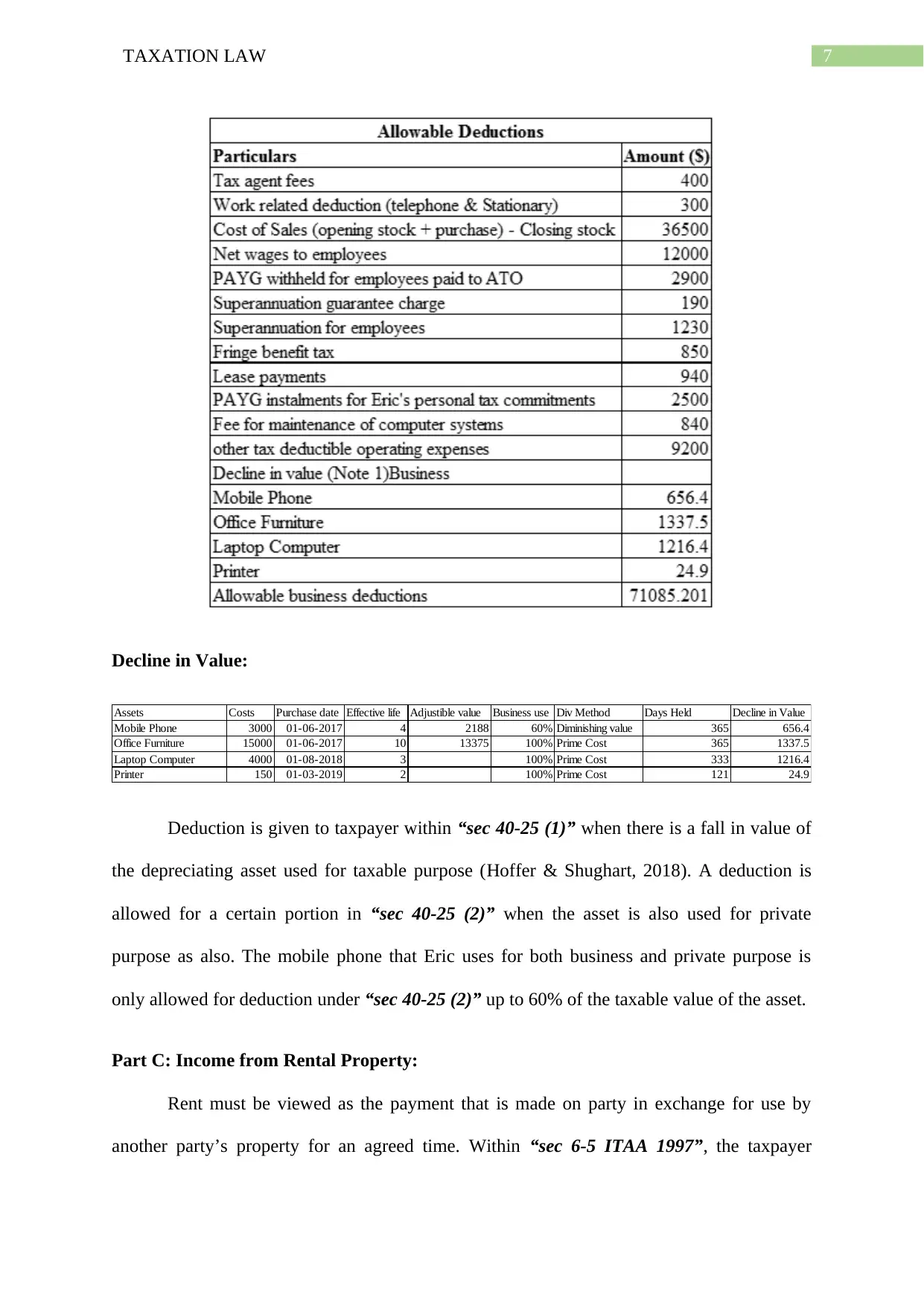
7TAXATION LAW
Decline in Value:
Assets Costs Purchase date Effective life Adjustible value Business use Div Method Days Held Decline in Value
Mobile Phone 3000 01-06-2017 4 2188 60% Diminishing value 365 656.4
Office Furniture 15000 01-06-2017 10 13375 100% Prime Cost 365 1337.5
Laptop Computer 4000 01-08-2018 3 100% Prime Cost 333 1216.4
Printer 150 01-03-2019 2 100% Prime Cost 121 24.9
Deduction is given to taxpayer within “sec 40-25 (1)” when there is a fall in value of
the depreciating asset used for taxable purpose (Hoffer & Shughart, 2018). A deduction is
allowed for a certain portion in “sec 40-25 (2)” when the asset is also used for private
purpose as also. The mobile phone that Eric uses for both business and private purpose is
only allowed for deduction under “sec 40-25 (2)” up to 60% of the taxable value of the asset.
Part C: Income from Rental Property:
Rent must be viewed as the payment that is made on party in exchange for use by
another party’s property for an agreed time. Within “sec 6-5 ITAA 1997”, the taxpayer
Decline in Value:
Assets Costs Purchase date Effective life Adjustible value Business use Div Method Days Held Decline in Value
Mobile Phone 3000 01-06-2017 4 2188 60% Diminishing value 365 656.4
Office Furniture 15000 01-06-2017 10 13375 100% Prime Cost 365 1337.5
Laptop Computer 4000 01-08-2018 3 100% Prime Cost 333 1216.4
Printer 150 01-03-2019 2 100% Prime Cost 121 24.9
Deduction is given to taxpayer within “sec 40-25 (1)” when there is a fall in value of
the depreciating asset used for taxable purpose (Hoffer & Shughart, 2018). A deduction is
allowed for a certain portion in “sec 40-25 (2)” when the asset is also used for private
purpose as also. The mobile phone that Eric uses for both business and private purpose is
only allowed for deduction under “sec 40-25 (2)” up to 60% of the taxable value of the asset.
Part C: Income from Rental Property:
Rent must be viewed as the payment that is made on party in exchange for use by
another party’s property for an agreed time. Within “sec 6-5 ITAA 1997”, the taxpayer
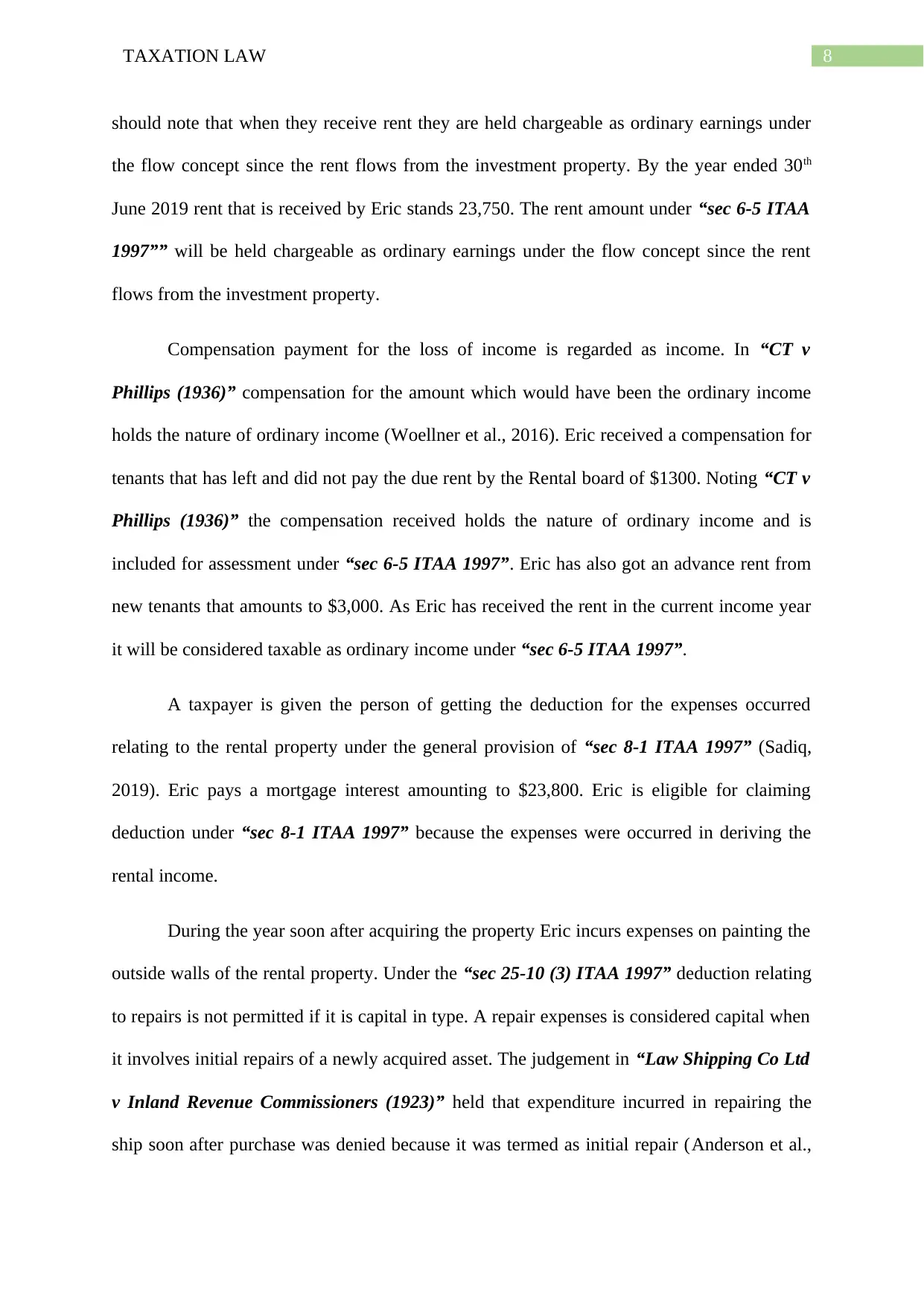
8TAXATION LAW
should note that when they receive rent they are held chargeable as ordinary earnings under
the flow concept since the rent flows from the investment property. By the year ended 30th
June 2019 rent that is received by Eric stands 23,750. The rent amount under “sec 6-5 ITAA
1997”” will be held chargeable as ordinary earnings under the flow concept since the rent
flows from the investment property.
Compensation payment for the loss of income is regarded as income. In “CT v
Phillips (1936)” compensation for the amount which would have been the ordinary income
holds the nature of ordinary income (Woellner et al., 2016). Eric received a compensation for
tenants that has left and did not pay the due rent by the Rental board of $1300. Noting “CT v
Phillips (1936)” the compensation received holds the nature of ordinary income and is
included for assessment under “sec 6-5 ITAA 1997”. Eric has also got an advance rent from
new tenants that amounts to $3,000. As Eric has received the rent in the current income year
it will be considered taxable as ordinary income under “sec 6-5 ITAA 1997”.
A taxpayer is given the person of getting the deduction for the expenses occurred
relating to the rental property under the general provision of “sec 8-1 ITAA 1997” (Sadiq,
2019). Eric pays a mortgage interest amounting to $23,800. Eric is eligible for claiming
deduction under “sec 8-1 ITAA 1997” because the expenses were occurred in deriving the
rental income.
During the year soon after acquiring the property Eric incurs expenses on painting the
outside walls of the rental property. Under the “sec 25-10 (3) ITAA 1997” deduction relating
to repairs is not permitted if it is capital in type. A repair expenses is considered capital when
it involves initial repairs of a newly acquired asset. The judgement in “Law Shipping Co Ltd
v Inland Revenue Commissioners (1923)” held that expenditure incurred in repairing the
ship soon after purchase was denied because it was termed as initial repair (Anderson et al.,
should note that when they receive rent they are held chargeable as ordinary earnings under
the flow concept since the rent flows from the investment property. By the year ended 30th
June 2019 rent that is received by Eric stands 23,750. The rent amount under “sec 6-5 ITAA
1997”” will be held chargeable as ordinary earnings under the flow concept since the rent
flows from the investment property.
Compensation payment for the loss of income is regarded as income. In “CT v
Phillips (1936)” compensation for the amount which would have been the ordinary income
holds the nature of ordinary income (Woellner et al., 2016). Eric received a compensation for
tenants that has left and did not pay the due rent by the Rental board of $1300. Noting “CT v
Phillips (1936)” the compensation received holds the nature of ordinary income and is
included for assessment under “sec 6-5 ITAA 1997”. Eric has also got an advance rent from
new tenants that amounts to $3,000. As Eric has received the rent in the current income year
it will be considered taxable as ordinary income under “sec 6-5 ITAA 1997”.
A taxpayer is given the person of getting the deduction for the expenses occurred
relating to the rental property under the general provision of “sec 8-1 ITAA 1997” (Sadiq,
2019). Eric pays a mortgage interest amounting to $23,800. Eric is eligible for claiming
deduction under “sec 8-1 ITAA 1997” because the expenses were occurred in deriving the
rental income.
During the year soon after acquiring the property Eric incurs expenses on painting the
outside walls of the rental property. Under the “sec 25-10 (3) ITAA 1997” deduction relating
to repairs is not permitted if it is capital in type. A repair expenses is considered capital when
it involves initial repairs of a newly acquired asset. The judgement in “Law Shipping Co Ltd
v Inland Revenue Commissioners (1923)” held that expenditure incurred in repairing the
ship soon after purchase was denied because it was termed as initial repair (Anderson et al.,
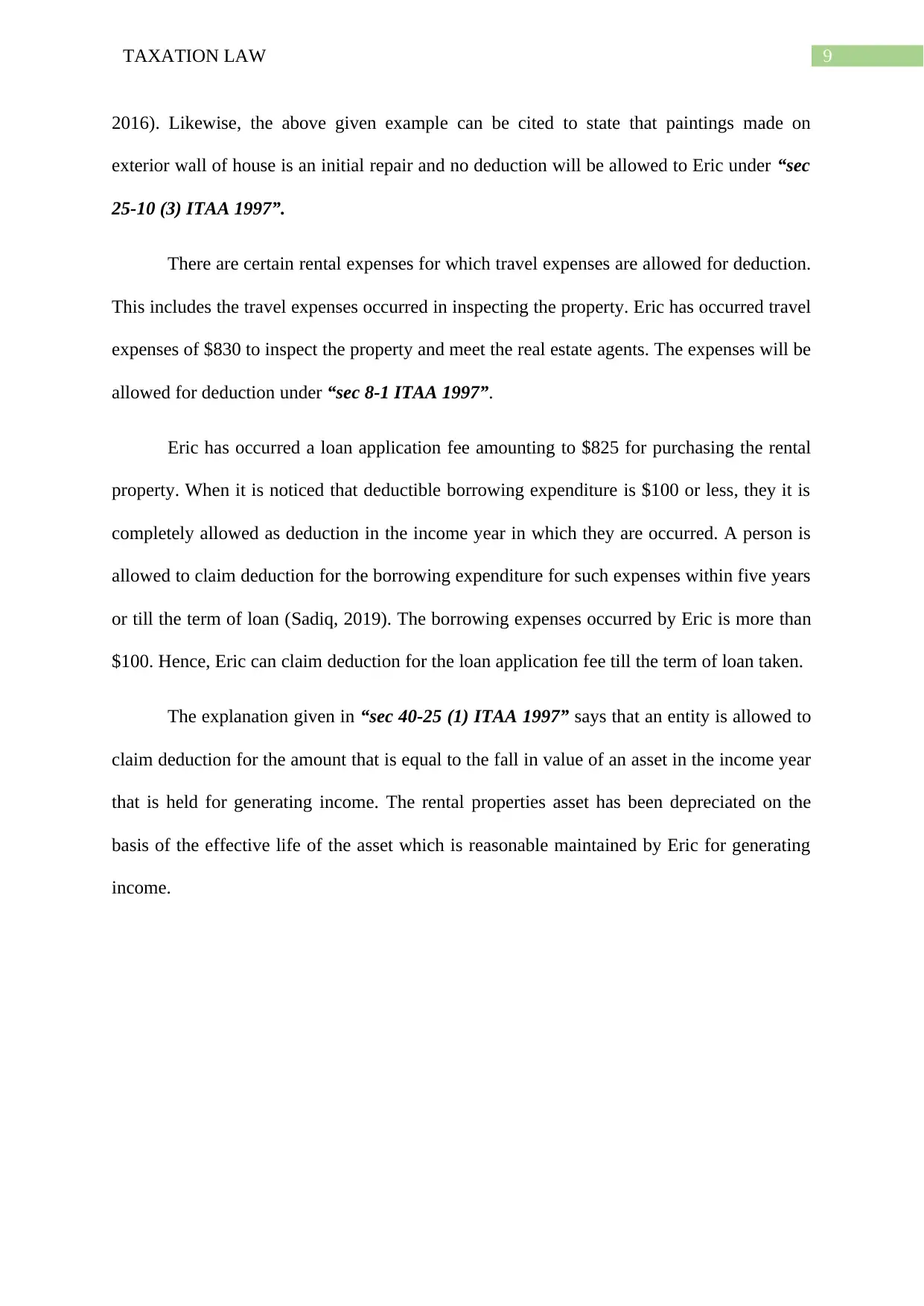
9TAXATION LAW
2016). Likewise, the above given example can be cited to state that paintings made on
exterior wall of house is an initial repair and no deduction will be allowed to Eric under “sec
25-10 (3) ITAA 1997”.
There are certain rental expenses for which travel expenses are allowed for deduction.
This includes the travel expenses occurred in inspecting the property. Eric has occurred travel
expenses of $830 to inspect the property and meet the real estate agents. The expenses will be
allowed for deduction under “sec 8-1 ITAA 1997”.
Eric has occurred a loan application fee amounting to $825 for purchasing the rental
property. When it is noticed that deductible borrowing expenditure is $100 or less, they it is
completely allowed as deduction in the income year in which they are occurred. A person is
allowed to claim deduction for the borrowing expenditure for such expenses within five years
or till the term of loan (Sadiq, 2019). The borrowing expenses occurred by Eric is more than
$100. Hence, Eric can claim deduction for the loan application fee till the term of loan taken.
The explanation given in “sec 40-25 (1) ITAA 1997” says that an entity is allowed to
claim deduction for the amount that is equal to the fall in value of an asset in the income year
that is held for generating income. The rental properties asset has been depreciated on the
basis of the effective life of the asset which is reasonable maintained by Eric for generating
income.
2016). Likewise, the above given example can be cited to state that paintings made on
exterior wall of house is an initial repair and no deduction will be allowed to Eric under “sec
25-10 (3) ITAA 1997”.
There are certain rental expenses for which travel expenses are allowed for deduction.
This includes the travel expenses occurred in inspecting the property. Eric has occurred travel
expenses of $830 to inspect the property and meet the real estate agents. The expenses will be
allowed for deduction under “sec 8-1 ITAA 1997”.
Eric has occurred a loan application fee amounting to $825 for purchasing the rental
property. When it is noticed that deductible borrowing expenditure is $100 or less, they it is
completely allowed as deduction in the income year in which they are occurred. A person is
allowed to claim deduction for the borrowing expenditure for such expenses within five years
or till the term of loan (Sadiq, 2019). The borrowing expenses occurred by Eric is more than
$100. Hence, Eric can claim deduction for the loan application fee till the term of loan taken.
The explanation given in “sec 40-25 (1) ITAA 1997” says that an entity is allowed to
claim deduction for the amount that is equal to the fall in value of an asset in the income year
that is held for generating income. The rental properties asset has been depreciated on the
basis of the effective life of the asset which is reasonable maintained by Eric for generating
income.
Secure Best Marks with AI Grader
Need help grading? Try our AI Grader for instant feedback on your assignments.
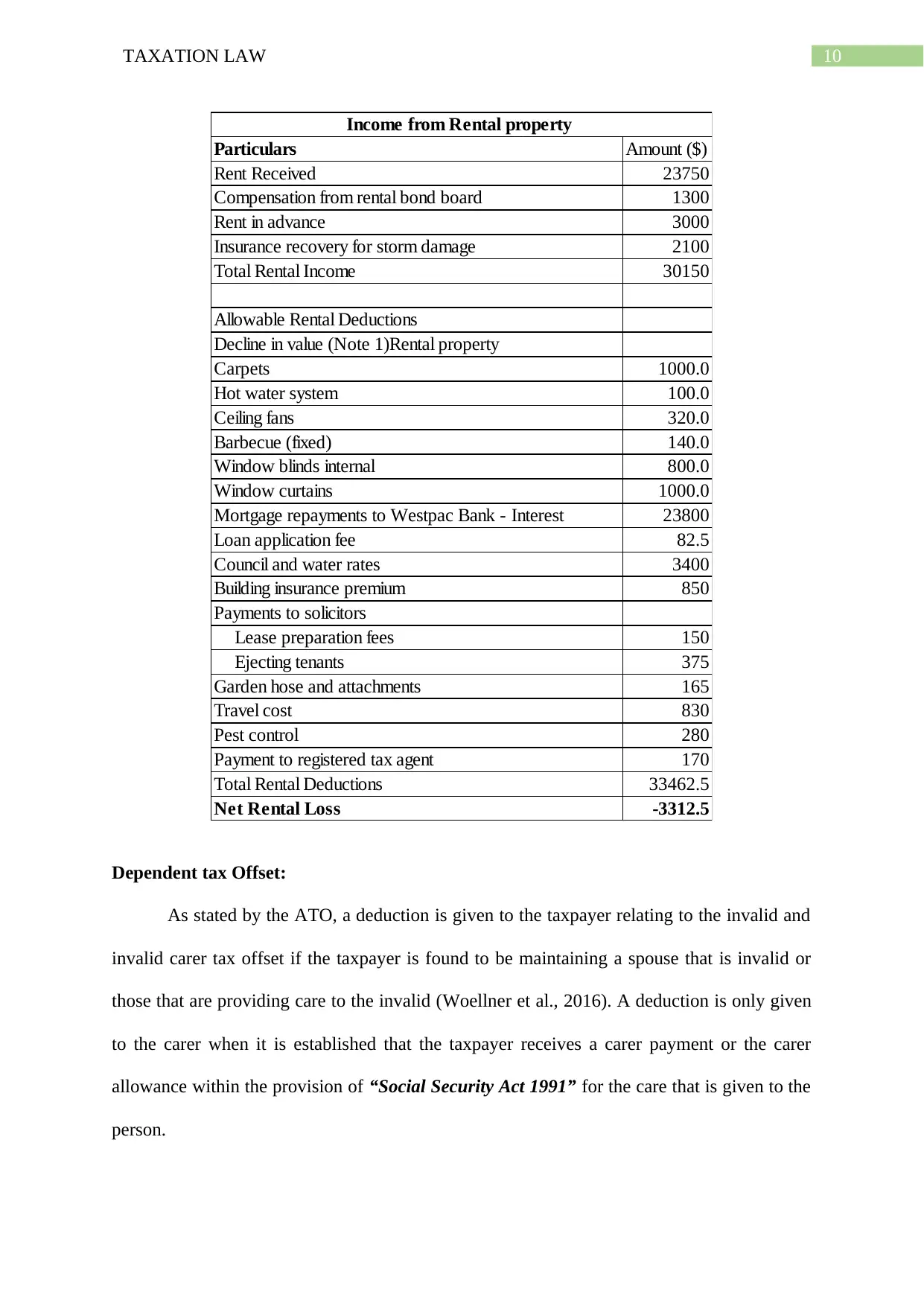
10TAXATION LAW
Particulars Amount ($)
Rent Received 23750
Compensation from rental bond board 1300
Rent in advance 3000
Insurance recovery for storm damage 2100
Total Rental Income 30150
Allowable Rental Deductions
Decline in value (Note 1)Rental property
Carpets 1000.0
Hot water system 100.0
Ceiling fans 320.0
Barbecue (fixed) 140.0
Window blinds internal 800.0
Window curtains 1000.0
Mortgage repayments to Westpac Bank - Interest 23800
Loan application fee 82.5
Council and water rates 3400
Building insurance premium 850
Payments to solicitors
Lease preparation fees 150
Ejecting tenants 375
Garden hose and attachments 165
Travel cost 830
Pest control 280
Payment to registered tax agent 170
Total Rental Deductions 33462.5
Net Rental Loss -3312.5
Income from Rental property
Dependent tax Offset:
As stated by the ATO, a deduction is given to the taxpayer relating to the invalid and
invalid carer tax offset if the taxpayer is found to be maintaining a spouse that is invalid or
those that are providing care to the invalid (Woellner et al., 2016). A deduction is only given
to the carer when it is established that the taxpayer receives a carer payment or the carer
allowance within the provision of “Social Security Act 1991” for the care that is given to the
person.
Particulars Amount ($)
Rent Received 23750
Compensation from rental bond board 1300
Rent in advance 3000
Insurance recovery for storm damage 2100
Total Rental Income 30150
Allowable Rental Deductions
Decline in value (Note 1)Rental property
Carpets 1000.0
Hot water system 100.0
Ceiling fans 320.0
Barbecue (fixed) 140.0
Window blinds internal 800.0
Window curtains 1000.0
Mortgage repayments to Westpac Bank - Interest 23800
Loan application fee 82.5
Council and water rates 3400
Building insurance premium 850
Payments to solicitors
Lease preparation fees 150
Ejecting tenants 375
Garden hose and attachments 165
Travel cost 830
Pest control 280
Payment to registered tax agent 170
Total Rental Deductions 33462.5
Net Rental Loss -3312.5
Income from Rental property
Dependent tax Offset:
As stated by the ATO, a deduction is given to the taxpayer relating to the invalid and
invalid carer tax offset if the taxpayer is found to be maintaining a spouse that is invalid or
those that are providing care to the invalid (Woellner et al., 2016). A deduction is only given
to the carer when it is established that the taxpayer receives a carer payment or the carer
allowance within the provision of “Social Security Act 1991” for the care that is given to the
person.
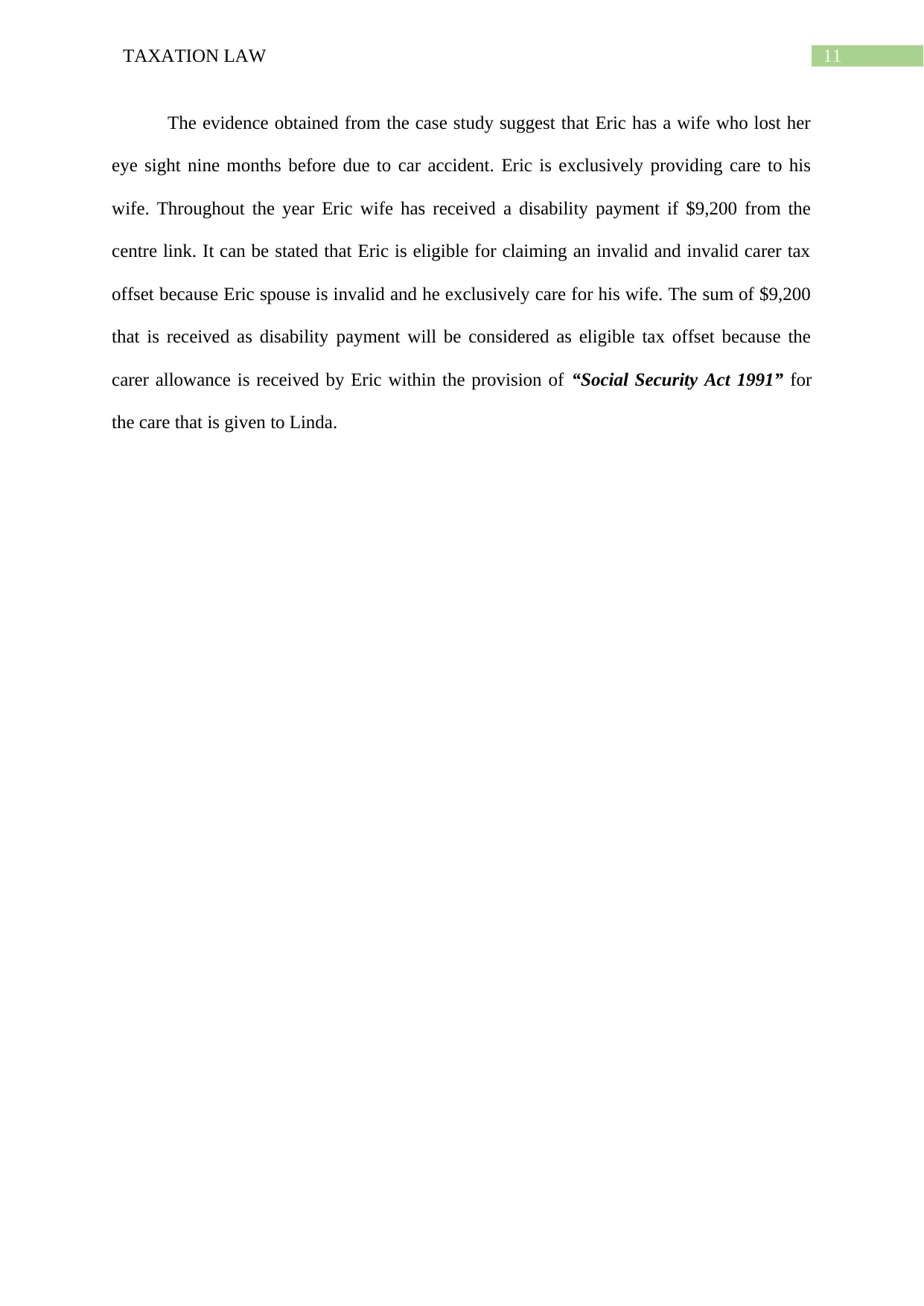
11TAXATION LAW
The evidence obtained from the case study suggest that Eric has a wife who lost her
eye sight nine months before due to car accident. Eric is exclusively providing care to his
wife. Throughout the year Eric wife has received a disability payment if $9,200 from the
centre link. It can be stated that Eric is eligible for claiming an invalid and invalid carer tax
offset because Eric spouse is invalid and he exclusively care for his wife. The sum of $9,200
that is received as disability payment will be considered as eligible tax offset because the
carer allowance is received by Eric within the provision of “Social Security Act 1991” for
the care that is given to Linda.
The evidence obtained from the case study suggest that Eric has a wife who lost her
eye sight nine months before due to car accident. Eric is exclusively providing care to his
wife. Throughout the year Eric wife has received a disability payment if $9,200 from the
centre link. It can be stated that Eric is eligible for claiming an invalid and invalid carer tax
offset because Eric spouse is invalid and he exclusively care for his wife. The sum of $9,200
that is received as disability payment will be considered as eligible tax offset because the
carer allowance is received by Eric within the provision of “Social Security Act 1991” for
the care that is given to Linda.
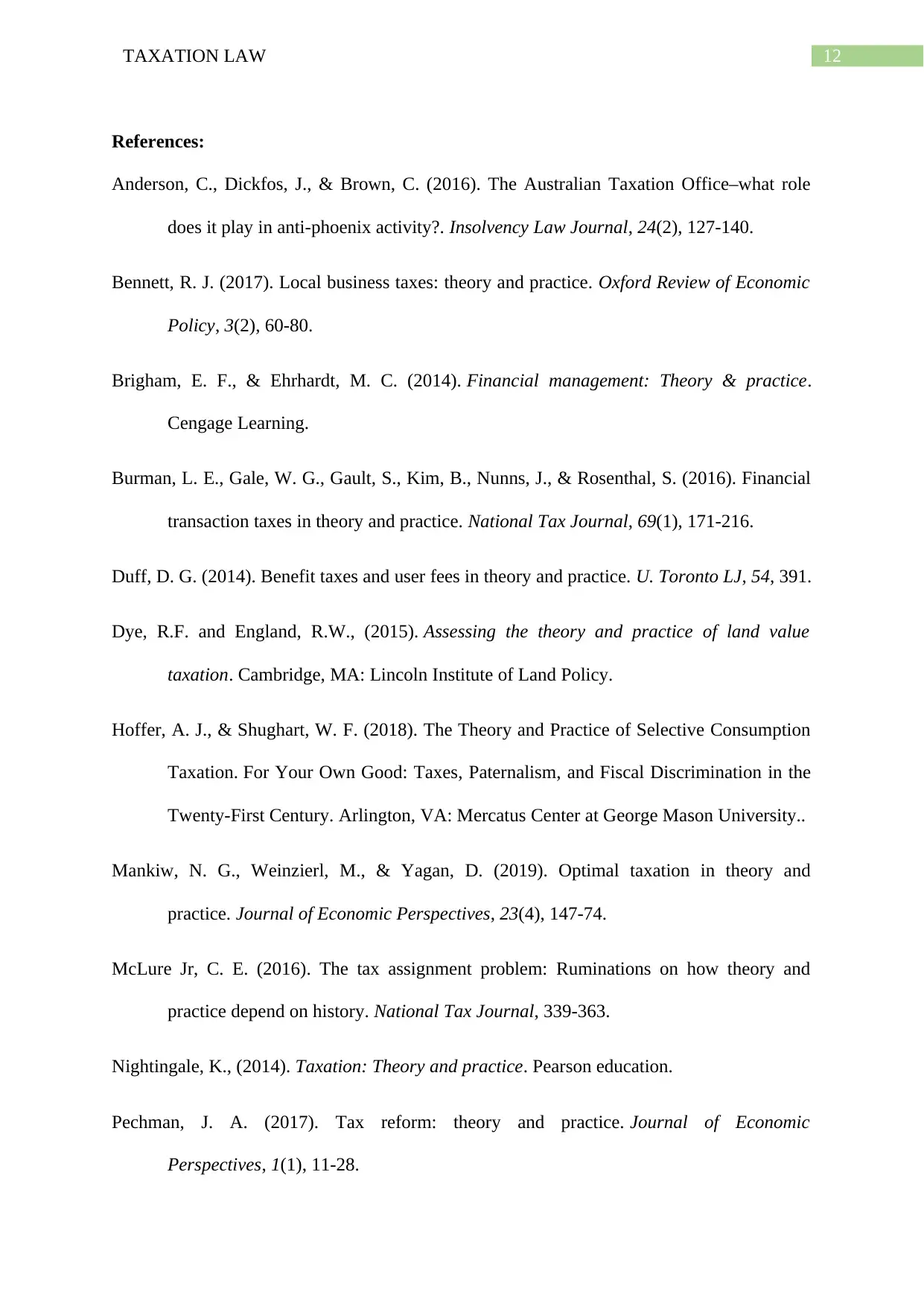
12TAXATION LAW
References:
Anderson, C., Dickfos, J., & Brown, C. (2016). The Australian Taxation Office–what role
does it play in anti-phoenix activity?. Insolvency Law Journal, 24(2), 127-140.
Bennett, R. J. (2017). Local business taxes: theory and practice. Oxford Review of Economic
Policy, 3(2), 60-80.
Brigham, E. F., & Ehrhardt, M. C. (2014). Financial management: Theory & practice.
Cengage Learning.
Burman, L. E., Gale, W. G., Gault, S., Kim, B., Nunns, J., & Rosenthal, S. (2016). Financial
transaction taxes in theory and practice. National Tax Journal, 69(1), 171-216.
Duff, D. G. (2014). Benefit taxes and user fees in theory and practice. U. Toronto LJ, 54, 391.
Dye, R.F. and England, R.W., (2015). Assessing the theory and practice of land value
taxation. Cambridge, MA: Lincoln Institute of Land Policy.
Hoffer, A. J., & Shughart, W. F. (2018). The Theory and Practice of Selective Consumption
Taxation. For Your Own Good: Taxes, Paternalism, and Fiscal Discrimination in the
Twenty-First Century. Arlington, VA: Mercatus Center at George Mason University..
Mankiw, N. G., Weinzierl, M., & Yagan, D. (2019). Optimal taxation in theory and
practice. Journal of Economic Perspectives, 23(4), 147-74.
McLure Jr, C. E. (2016). The tax assignment problem: Ruminations on how theory and
practice depend on history. National Tax Journal, 339-363.
Nightingale, K., (2014). Taxation: Theory and practice. Pearson education.
Pechman, J. A. (2017). Tax reform: theory and practice. Journal of Economic
Perspectives, 1(1), 11-28.
References:
Anderson, C., Dickfos, J., & Brown, C. (2016). The Australian Taxation Office–what role
does it play in anti-phoenix activity?. Insolvency Law Journal, 24(2), 127-140.
Bennett, R. J. (2017). Local business taxes: theory and practice. Oxford Review of Economic
Policy, 3(2), 60-80.
Brigham, E. F., & Ehrhardt, M. C. (2014). Financial management: Theory & practice.
Cengage Learning.
Burman, L. E., Gale, W. G., Gault, S., Kim, B., Nunns, J., & Rosenthal, S. (2016). Financial
transaction taxes in theory and practice. National Tax Journal, 69(1), 171-216.
Duff, D. G. (2014). Benefit taxes and user fees in theory and practice. U. Toronto LJ, 54, 391.
Dye, R.F. and England, R.W., (2015). Assessing the theory and practice of land value
taxation. Cambridge, MA: Lincoln Institute of Land Policy.
Hoffer, A. J., & Shughart, W. F. (2018). The Theory and Practice of Selective Consumption
Taxation. For Your Own Good: Taxes, Paternalism, and Fiscal Discrimination in the
Twenty-First Century. Arlington, VA: Mercatus Center at George Mason University..
Mankiw, N. G., Weinzierl, M., & Yagan, D. (2019). Optimal taxation in theory and
practice. Journal of Economic Perspectives, 23(4), 147-74.
McLure Jr, C. E. (2016). The tax assignment problem: Ruminations on how theory and
practice depend on history. National Tax Journal, 339-363.
Nightingale, K., (2014). Taxation: Theory and practice. Pearson education.
Pechman, J. A. (2017). Tax reform: theory and practice. Journal of Economic
Perspectives, 1(1), 11-28.
Paraphrase This Document
Need a fresh take? Get an instant paraphrase of this document with our AI Paraphraser
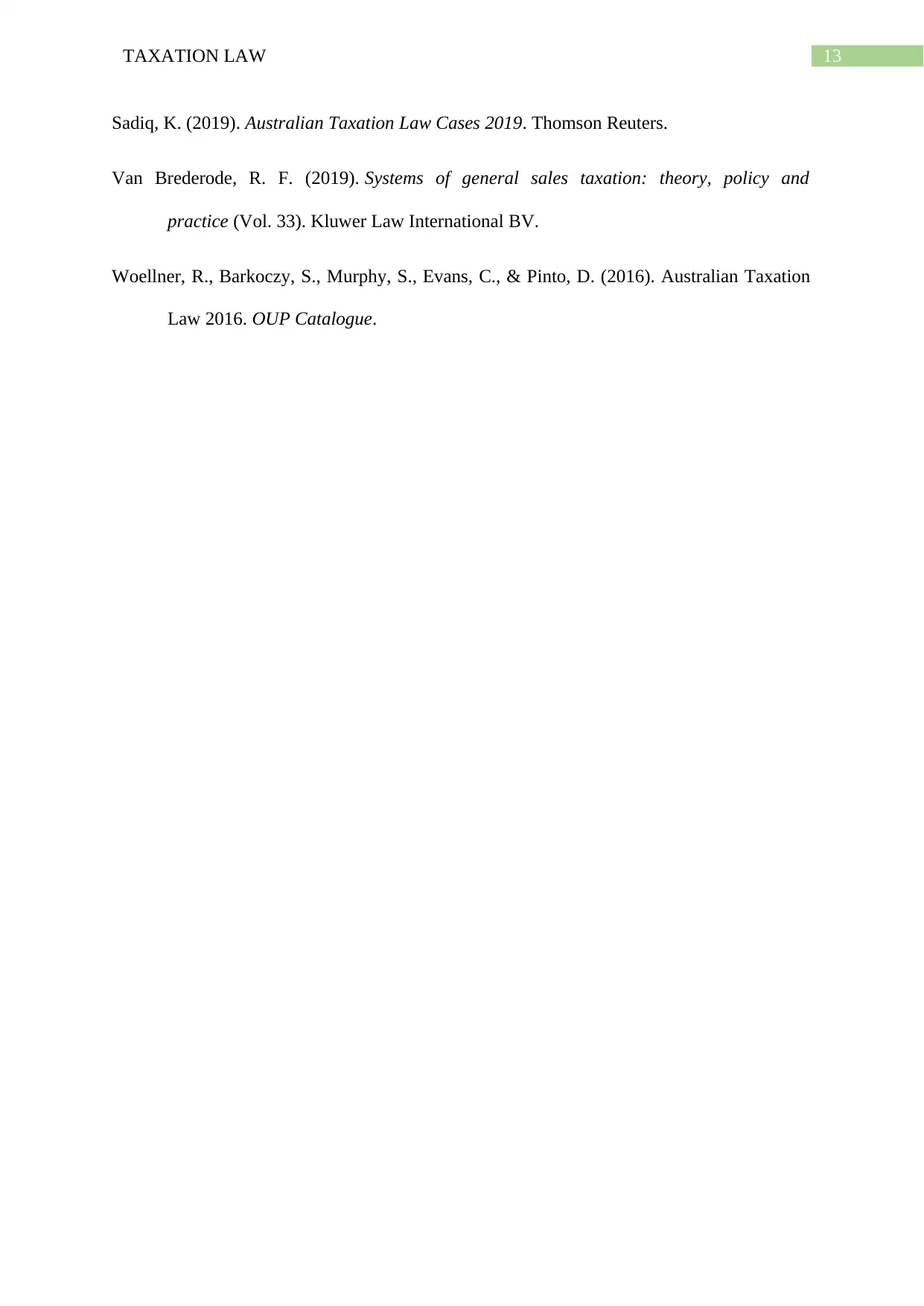
13TAXATION LAW
Sadiq, K. (2019). Australian Taxation Law Cases 2019. Thomson Reuters.
Van Brederode, R. F. (2019). Systems of general sales taxation: theory, policy and
practice (Vol. 33). Kluwer Law International BV.
Woellner, R., Barkoczy, S., Murphy, S., Evans, C., & Pinto, D. (2016). Australian Taxation
Law 2016. OUP Catalogue.
Sadiq, K. (2019). Australian Taxation Law Cases 2019. Thomson Reuters.
Van Brederode, R. F. (2019). Systems of general sales taxation: theory, policy and
practice (Vol. 33). Kluwer Law International BV.
Woellner, R., Barkoczy, S., Murphy, S., Evans, C., & Pinto, D. (2016). Australian Taxation
Law 2016. OUP Catalogue.
1 out of 14
Related Documents
Your All-in-One AI-Powered Toolkit for Academic Success.
+13062052269
info@desklib.com
Available 24*7 on WhatsApp / Email
![[object Object]](/_next/static/media/star-bottom.7253800d.svg)
Unlock your academic potential
© 2024 | Zucol Services PVT LTD | All rights reserved.





